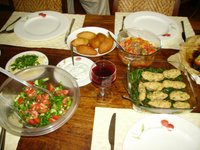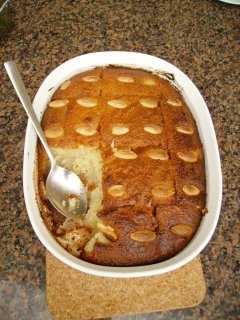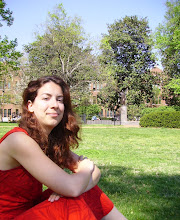 When my hosts make too many different dishes, it's hard to choose which ones I should put in the title. So, to make it easier for myself, I just call it a "feast". And when I walk into Julia's kitchen, I am certainly struck by what a feast she has prepared for me. The menu tonight is "Syrian-Turkish", because Julia's grandparents are originally from Syria. They lived in a purely Syrian neighbourhood in Mersin and mostly spoke Arabic. Julia (officially spelled Hülya) can understand Arabic, but hardly speaks it. Turkish is no problem, she even worked as an interpreter for a while, jetting back and forth to Istanbul close to a hundred times.
When my hosts make too many different dishes, it's hard to choose which ones I should put in the title. So, to make it easier for myself, I just call it a "feast". And when I walk into Julia's kitchen, I am certainly struck by what a feast she has prepared for me. The menu tonight is "Syrian-Turkish", because Julia's grandparents are originally from Syria. They lived in a purely Syrian neighbourhood in Mersin and mostly spoke Arabic. Julia (officially spelled Hülya) can understand Arabic, but hardly speaks it. Turkish is no problem, she even worked as an interpreter for a while, jetting back and forth to Istanbul close to a hundred times.Still, she sees herself more as "Arab-Turkish" than as "Turkish". Her parents also stimulated her to find a husband within the Arab community. Not that much has changed...Julia's niece in Istanbul is marrying a "real" Turk, and that was the most important thing that could be said about him. "Ah well, there aren't that many Arab Turks in Istanbul...", explained the father of the bride-to-be. Before meeting Julia, I had never heard of the Syrian community in Turkey, but I'm learning fast. First of all, there's a difference between the Christian (Orthodox) Syrians and the "Arab" Islamic Syrians, who live in the South-East. She tells me how in the sixties/seventies, her uncle was an engineer for a big mining company, but to maintain this position, his Arab roots were kept secret. His parents could not even visit him, because their Arabic accent would give them away.
 So is this meal truly non-Turkish? I recognize the stuffed grape leaves! But no, this is the pretty similar Sarma, which means "rolled". The stuffing is a bit different, as it also includes meat. Also familiar is the Börek (bread with feta cheese) and the Lahmacun ("Turkish pizza"); the word comes from the Arabic Lahm al acun,which means "meat on bread".
So is this meal truly non-Turkish? I recognize the stuffed grape leaves! But no, this is the pretty similar Sarma, which means "rolled". The stuffing is a bit different, as it also includes meat. Also familiar is the Börek (bread with feta cheese) and the Lahmacun ("Turkish pizza"); the word comes from the Arabic Lahm al acun,which means "meat on bread".The Humus (chickpea dip) and Baba gannuç (aubergine dish) do seem less Turkish, though not exclusively Syrian.
Julia has made all these dishes herself, with one exception; the İçli Köfte.
 These snacks made of bulghur and filled with meat were so complicated to prepare that Julia's mother was summoned to help out. As a child, Julia once asked her mom why the other kids at school went home and had sandwiches for lunch. They themselves had a warm meal every afternoon (as well as in the evenings).
These snacks made of bulghur and filled with meat were so complicated to prepare that Julia's mother was summoned to help out. As a child, Julia once asked her mom why the other kids at school went home and had sandwiches for lunch. They themselves had a warm meal every afternoon (as well as in the evenings)."Well," her mother answered, "probably those families don't have that much money..."
That was the only explanation she could give for such behaviour (in retrospect just typical Dutch food culture).
 After about ten different dishes I have to unbutton my jeans again...and there is still dessert! The Şam Tatlısı, made with cream-of-wheat and yoghurt, officially means "Sweets from Damascus". The capital of Syria is also called "ash-Sham", meaning "the Northern". Julia tells me she took Arabic as a minor at university, but especially the Arabic script was very difficult to learn.
After about ten different dishes I have to unbutton my jeans again...and there is still dessert! The Şam Tatlısı, made with cream-of-wheat and yoghurt, officially means "Sweets from Damascus". The capital of Syria is also called "ash-Sham", meaning "the Northern". Julia tells me she took Arabic as a minor at university, but especially the Arabic script was very difficult to learn. 
It would actually be interesting to ask a "real Syrians" what they make of this meal. Is it similar to what they make, or has it been "Turkified"?
With the Damascan dessert and a cup of tea, Julia and I sit down to enjoy the Eurovision Song Festival. Quite amusing, especially the Finnish monster hard-rockers! We both make a top ten of who we think will win. This makes the results even more exciting, especially since the non-typical Finnish entry wins by a landslide.

No comments:
Post a Comment